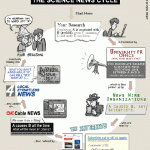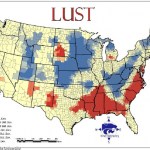Journalism
Two announcements landed in my Inbox yesterday and are worth passing along:
1) The Bastiat Prize for Online Journalism is now accepting nominations:
# Articles must have been published for the first time between 1 July 2008 and 30 June 2009.
# Entries must state clearly the website where each article appeared and the date that each article was published.
# Consideration will be given to the articles on the following criteria: intellectual coherence; persuasiveness; wit and relevance; clarity and simplicity; wider impact (as indicated by additional information provided by entrants in the…
Earlier this year, 23 international experts in science, media, and policy gathered at a science communication workshop in Washington, D.C. to present a number of guidelines for more effective science communication in the face of changing public perceptions. An article describing the eight steps they outlined appeared last week in the June issue of Nature Biotechnology. ScienceBlogger Matthew Nisbet was among the workshop participants and is one of the paper's two primary authors. The first step in his plan? "Scientists and science organizations should pursue a trust- and dialogue-based…
In a new post, scibling Bora asks whether science blogs are "real" publications and should be cited in other publications - like research articles. That's an interesting debate, and I encourage you to participate. I'm not going to get into it right now. Instead, I want to quote this section of his post:
There is a very interesting discussion on this topic in the comments section at the Sauropod Vertebra Picture of the Week blog, discussing the place of science blogs in the new communication ecosystem and if a blog post can be and should be cited. What counts as a "real publication"? Is the…
Turns out DC has, or once did have, a hidden subterranean labyrinth - and you thought it was just a plot device from last fall's South Park election special! Even better, it was dug by a lepidopterist. Take that, you engineers!
ONE of the oddest hobbies in the world is that of Dr. H. G. Dyar, international authority on moths and butterflies of the Smithsonian Institution, who has found health and recreation in digging an amazing series of tunnels beneath his Washington home.
The New York Times revealed its 50 most looked-up words, and Nieman Journalism Lab had commentary:
"All of the 25-cent…
Over at Cosmic Variance, Julianne is annoyed at Nature's embargo policy. It seems that somebody or another posted a paper to the arxiv while submitting it to Nature, and included a note on the arxiv submission asking people to abide by Nature's embargo.
So, instead of blogging about the Incredibly Exciting Discovery (which I'd loooove to talk about), I'm writing about what a ridiculous fiction the authors are asking us all to participate in, for the sake of the authors' potentially getting a publication accepted to Nature. The authors advertised a paper to thousands of interesting, engaged…
If you've been following the Jared Diamond/New Yorker controversy, or my ongoing posts on journalism vs. blogging (here, here, here, here, here), you might be intrigued by this conversation about the culture of fact-checking in journalism, between journalism professor Jay Rosen and programmer Dave Winer, in their podcast series Rebooting the News. Consider this riddle: how is fact-checking in journalism like (or unlike) debugging a computer program?
Here's Rosen's take on it:
One of the features of a rebooted news system would actually be borrowed from the tech world. And it's the notion of…
In the June Atlantic Monthly, Joshua Wolf Shenk has a long, moving article about what may be the longitudinal study of all longitudinal studies - the Harvard Study of Adult Development (Grant Study), begun in 1937. Its creator Arlie Beck planned to track 268 "healthy, well-adjusted" men from their sophomore year at Harvard through careers, marriage, families, retirement and eventually death - and somehow, from this glut of longitudinal data, to glean the secrets of "successful living."
But the portrait Shenk paints is as full of pathos as it is of success.
Delving into the case files, now…
Following up on an excellent post she wrote earlier this month, Jessica Palmer at Bioephemera brings us an update on the lawsuit against Jared Diamond and The New Yorker. You may recall that this lawsuit alleges that a story written by Diamond and published in The New Yorker defamed its subject (and Diamond's source) New Guinean driver Daniel Wemp, as well as Henep Isum, another man featured in the story but never interviewed by Diamond nor contacted by fact-checkers from The New Yorker. As described in the earlier post at Bioephemera:
Diamond's main source, a New Guinean driver named…
This would be funnier if it weren't so painfully true. Also see the sequel.
I didn't get to this for a few days because I was working too hard to blog last week. In the meantime, Language Log responded with an especially egregious example of this sort of oversimplification.
Cartoon by Jorge Cham, via Sheril at the Intersection.
Just when I was wondering why there hasn't been more mainstream coverage of the Jared Diamond/New Yorker lawsuit I blogged about at the beginning of this month, Columbia Journalism Review has an update. And in a recent article in Science, Diamond commented, saying "The complaint has no merit at all."
Oddly, the Science article (which is unfortunately subscription-only) frames this whole situation as a conflict between different disciplines - mainly science and journalism.
Three worlds collide in this case. First is the world of science, specifically anthropology, which uses fieldwork and…
A few days ago I asked how do we break this cycle of news reports based on terrible misreading of the scientific literature literature. All these reports do is spread misinformation and undermine trust in scientific research.
Well, the British National Health System has the answer! Via Ben Goldacre, I've found my new, favorite website, Behind the Headlines at NHS. It's the Snopes.com equivalent for shoddy science journalism. Every day they examine what health news is making the headlines, share it with scientific and clinical experts, and they report on the science in a way that's…
Yesterday, the entire world changed noticeably as the media, accompanied by some scientists, unveiled a stunning fossilised primate. The creature has been named Darwinius masillae, but also goes by Ida, the Link, the Chosen One and She Who Will Save Us All.
The new fossil is remarkably complete and well-preserved, although the media glossed over these facts in favour of the creature's ability to cure swine flu. Ida was hailed as a "missing link" in human evolution, beautifully illustrating our transition from leaping about in trees to rampant mass-media sensationalism.
Speaking to a group…
This week, Nieman Journalism Lab is running a fascinating series of video interviews with the New York Times' R&D group on the possible future face of news media. I know - you're wondering why the supposedly financially moribund NYT is wasting money on nerds who play with Kindles. Who do they think they are, Google? But it might be a good strategy after all.
As Fortune and the Columbia Journalism Review recently pointed out, with outlets all around them slashing premium content (like science), the NYT's best strategy may be to instead become increasingly "elite:"
Meanwhile, the company is…
In the wake of some recent deaths in Edmonton of teenagers who took Ecstasy, DrugMonkey gets irritated with a doctor who made some proclamation to the press:
I'm particularly exercised over an article which quotes Charles Grob, M.D. (UCLA page):
Charles Grob believes there is a strong chance that a deadly batch of adulterated pills is making the rounds in and around Edmonton, though health officials and law-enforcement groups have issued no such public warning.
Dr. Grob, a professor of psychiatry at UCLA, was the first U. S. researcher to conduct human tests of methylenedioxymethamphetamine…
You've probably already heard that Merck and Elsevier are being called on the carpet for producing a medical "journal" - Australasian Journal of Bone and Joint Medicine - that appeared to be peer-reviewed, but was actually a marketing ploy to encourage doctors to prescribe Merck drugs. Ouch.
Elsevier told The Scientist,
"Elsevier acknowledges the concern that the journals in question didn't have the appropriate disclosures," the statement continued. "It is worth noting that project in question was produced 6 years ago and disclosure protocols have evolved since 2003. Elsevier's current…
My clinical counterpart, surgical oncologist Dr David Gorski, has an excellent post up today at Science-Based Medicine on the irresponsible and misleading information being provided at The Huffington Post during the current H5N1/2009 influenza ("swine flu") outbreak. "The Huffington Post's War on Medical Science: A Brief History" provides a cautionary tale for us in embracing web-based news sources as our excellent print newspapers are going by the wayside.
Within the post, Dr Gorski shows that he is even more familiar with my writing than myself by citing a post at the old Terra Sig on the…
Some Kansas State University geographers have come up with some interesting maps of the US that purport to show the national distribution of the seven deadly sins. Obviously they can't gauge "sinfulness" directly, so they're using proxy data - such as STD infection rate to measure lust (above).
It's a fun thought exercise to assess the pros and cons of the various methodologies for measuring each sin. Consider greed, which was (as described in the Las Vegas Sun) calculated by comparing average incomes with the total number of inhabitants living beneath the poverty line. How does that…
It occurs to me that there might be an interesting parallel to the conundrum we discussed about whether it's better to engage with a scientist giving off a shady vibe or to back away with all due haste. It's not a perfect parallel, but there are some similar issues at work.
Should scientists and physicians engage with the Huffington Post?
If you follow the ScienceBlogs frontpage, you will have gathered by now that the view in these parts is that HuffPo's science-fu is not strong. Folks like PalMD and Mike the Mad Biologist and Orac have detailed some of the ways the "health and wellness"…
I was recently reading A Scientist's Guide to Talking With the Media, a useful and clearheaded book by Richard Hayes and Daniel Grossman of the Union of Concerned Scientists. Emphasizing the importance of science outreach, Hayes and Grossman praise the pop-sci luminaries who followed in the footsteps of Carl Sagan:
With his intriguing investigations into the activities of everyday life, Fisher joins a distinguished fraternity of public scientists that includes Barry Commoner, Jared Diamond, Sylvia Earle, Paul Erlich, and E.O. Wilson. These are some of the most famous of the hundreds of…
I've had the Quiche Moraine post on editing open in a browser tab for far too long, now, but it deserves a more prominent comment than just a link in the daily links dump. It really is an excellent presentation of the important role of editing:
Editing requires the strange ability to stand in the place of the audience and the author simultaneously. As an editor reads a piece, whether it be a story or a journal article, they have to understand what the author intended to say without losing track of not just what one individual reader will take away, but how the piece will come across to…




